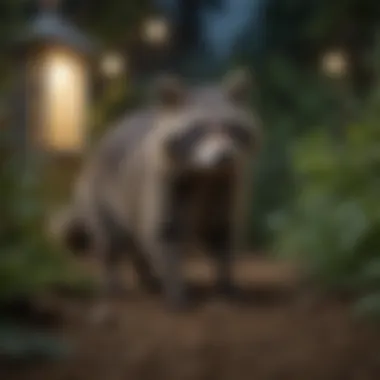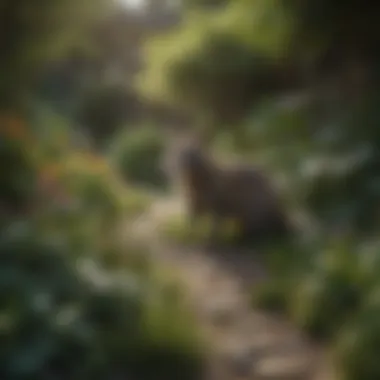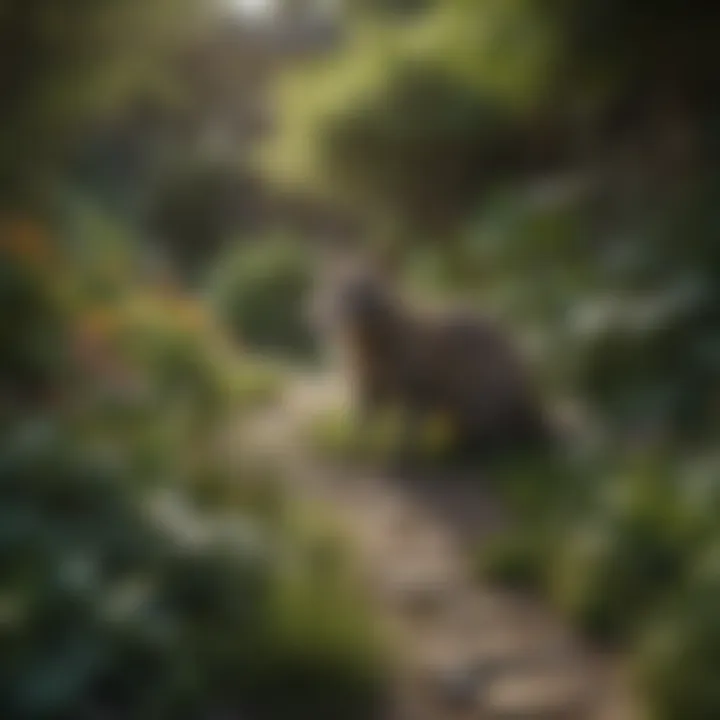Effective Strategies to Keep Raccoons Out of Your Garden


Intro
Gardeners often find themselves in an uphill battle when it comes to protecting their green spaces from unwelcome guests. Among these intruders, raccoons can pose significant challenges. These creatures, known for their dexterous hands and clever problem-solving abilities, can wreak havoc in a well-tended garden. If you’ve ever come across overturned pots or missing vegetables, you might suspect raccoons are up to no good.
Understanding raccoons is the first step in devising effective strategies to keep them at bay. They are nocturnal, intelligent, and incredibly resourceful, relying heavily on their sense of touch and smell. This adaptive behavior often leads them to raid gardens for tasty treats like fruits, vegetables, and even pet food left outside. Therefore, preventing raccoons requires a multifaceted approach that not only incorporates deterrents but also transforms the garden environment.
This guide will delve into various practical strategies to repel raccoons without resorting to harmful practices. From natural repellents to garden modifications, the ideas presented here aim to empower homeowners and horticulturists alike. Safeguarding your outdoor haven does not have to come at the expense of the ecosystem around you. Let's explore how you can maintain harmony between your desired landscape and the local wildlife.
Understanding Raccoon Behavior
Gaining insight into raccoon behavior is crucial for effectively protecting your garden. These nocturnal creatures possess certain traits and habits that make understanding their lifestyle significantly beneficial. Raccoons are resourceful foragers, known for their dexterity and intelligence. Identifying their patterns can help homeowners implement strategies that effectively deter these clever critters while preserving the ecosystem. When you comprehend the way raccoons interact with their environment, it empowers you to devise targeted solutions that will keep them at bay.
Physical Characteristics
Raccoons are easily recognizable due to their distinctive physical features. They have a stocky build, with thick grayish fur complemented by a characteristic black mask-like pattern across their eyes. An adult raccoon typically weighs between 10 to 30 pounds, and their body can range from two to three feet in length. One of their most notable traits is their paws, which resemble that of a small human hand.
These paws give raccoons their remarkable ability to manipulate objects. They can create quite a mess in a garden, having the knack for accessing bins or unearthing plants in their pursuit of food.
Understanding these physical traits can help gardeners anticipate how raccoons may navigate their way into desired spaces, particularly when it comes to securing potential food sources.
Diet and Feeding Habits
Raccoons are opportunistic omnivores; their diet is diverse, consisting of fruits, vegetables, insects, and even small animals. This adaptability makes them particularly challenging to deter since they will sample whatever is readily available. In gardens, they may be drawn to ripe tomatoes, sweet corn, or even pet food left unattended outside.
It's essential to recognize that raccoons possess a strong sense of smell, which drives their foraging behavior. They often rely on food with strong aromas, making your homemade compost pile or trash can very alluring.
To repel raccoons effectively, homeowners might consider removing attractive food sources. By keeping gardens tidy and stored food secured, you can significantly reduce the likelihood of a raccoon feast.
Active Hours and Habitat Preferences
Raccoons are primarily nocturnal, being most active during the twilight hours of the evening and the early morning. This rest schedule can catch gardeners off guard, as many may not realize raccoons could be prowling the night right under their very noses.
In terms of habitat, raccoons thrive in both rural and urban environments, often taking refuge in trees, attics, and sheds. They prefer areas where they have access to water sources, making gardens near streams or ponds particularly appealing.
When evaluating your garden's layout, consider whether natural features could be inviting raccoons. By making your garden less accessible during their active hours and modifying your landscape, you might be able to disrupt their preferred habitats, thus protecting your garden from unwanted guests.
Identifying Raccoon Damage
Identifying raccoon damage is crucial for gardeners who want to protect their plants and maintain a thriving outdoor space. Early detection of these pesky intruders often makes the difference between a garden flourishing and a battleground of destruction. Raccoons are notoriously curious and resourceful, which means that without a keen eye, they can easily wreak havoc while residents remain unaware. Understanding what raccoon damage looks like can help you intervene effectively, thereby saving your hard work and investment in the garden.
Signs of Infestation
Recognizing the signs of raccoons in your garden can often be the first line of defense. Here’s what to look out for:
- Tracks and Trails: Raccoons have distinctive paw prints that can often be spotted around your garden. They typically show a rounded footprint with long toes.
- Digging: One of the most telltale signs is holes in the ground. Raccoons are known for digging in search of food. If you notice irregular holes throughout your garden beds, it’s a good indication you might have visitors.
- Nestlike Structures: During the mating season, raccoons can build nests, especially in dense shrubs or tree hollows. Seeing displaced leaves or ripped-up plant material can signal their presence.
- Scat: Raccoon droppings are easily recognizable. They are tubular and often contain seeds, fur, or bits of undigested food. Spotting scat can alert you to their activity in the area.
As a seasoned gardener, keeping a watchful eye on your space can prevent more significant damage. If you notice any of these signs, then taking swift action is imperative.
Common Gardening Targets
Raccoons are omnivorous, which simply means they’ll chow down on just about anything. However, there are specific targets in a garden they may find particularly enticing:
- Vegetables: Sweet corn, tomatoes, and cucumbers are prime targets, not just for their taste but also because they tend to be at a height raccoons find easy to reach.
- Fruits: Soft fruits like strawberries and blueberries can be picked clean in no time. Their sweetness is like a cherry on top of a raccoon’s diet.
- Garbage Bins: Though not strictly a garden item, improperly secured trash can attract raccoons, drawing them into your yard in search of a snack.
- Bird Feeders: Raccoons are clever and will climb to get to feeders. If you’re feeding birds, you might inadvertently be inviting in raccoons as well.
By knowing these targets, you can take proactive measures to safeguard your garden. If you understand which plants raccoons might favor, you can find creative ways to protect them.
"A gardener’s best friend is awareness. Spot the signs early, and you might just save your beloved plants from a raccoon rampage."
In summary, identifying raccoon damage and understanding their behavior is a vital part of preventing them from causing mayhem in your garden. So keep your eyes peeled and be prepared!
Natural Deterrents


Raccoons are notorious garden raiders, and their clever antics can lead to significant frustration for homeowners. Employing natural deterrents is critical in defending your garden against these agile intruders. Not only do these strategies minimize harm to the environment, but they also maintain the ecosystem balance. This article section outlines how you can utilize natural substances and plants to send raccoons packing without resorting to harmful chemicals.
Using Spicy Repellents
Raccoons have a heightened sense of smell, which makes spicy substances an effective deterrent. Ingredients like cayenne pepper and chili powder can be sprinkled around the perimeter of your garden to create an unpleasant experience for these critters. However, it's important to bear in mind that this method requires regular reapplication, especially after rainfall. Mixing cayenne pepper with water to create a spray can also extend its reach—just make sure to shake well before each use.
Here are a few key considerations for using spicy repellents:
- Ethical Impact: These natural deterrents do not harm the raccoons but rather encourage them to seek food elsewhere.
- Cost-Effective: Spices are generally inexpensive, making this an appealing option for many gardeners.
- Sensitivity: Be cautious if you have pets, as some animals may also dislike the scent or taste.
Essential Oils and Their Effects
Essential oils can pack quite a punch when it comes to deterring raccoons. Oils such as peppermint, citrus, and eucalyptus are particularly effective. Not only do these oils have a strong scent that raccoons find unpleasant, but they also offer the added benefit of a pleasant fragrance for humans. To use essential oils:
- Dilution: Mix a few drops of essential oil with water in a spray bottle.
- Target Areas: Spray it around your garden boundaries or areas where raccoons tend to frequent.
- Frequent Reapplication: Like spicy repellents, essential oils need to be reapplied regularly to be effective, especially after rain.
"Spicy odors and strong fragrances can provide a natural barrier to curious raccoons, making your garden less appealing to them."
Planting Raccoon-Repellent Flora
Planting certain types of flora can serve as an indirect deterrent against raccoons. Herbs and plants with strong smells can act as a barricade that raccoons typically avoid. Here are some excellent flora choices:
- Lavender: Not only pleasant for humans, it’s a pungent plant that can ward off several garden pests, including raccoons.
- Rosemary: This hardy herb thrives in gardens and gives off a scent that is often off-putting to raccoons.
- Barberry: Its thorny stems serve a dual purpose of being an effective barrier and an unpleasant environment for raccoons.
With these natural deterrent strategies, you're not only protecting your garden but also taking a step towards a more sustainable approach to wildlife management. These methods promote a healthier garden ecosystem while being effective in keeping those pesky raccoons at bay.
Physical Barriers
In the quest to maintain a pristine garden, the concept of physical barriers emerges as both a formidable shield and a pivotal strategy in repelling raccoons. These crafty creatures possess both the intelligence and dexterity to navigate their environment, making it essential for gardeners to implement effective measures. Physical barriers not only protect your prized plants but also create a clear demarcation that signals to raccoons that your garden is off-limits.
The importance of physical barriers cannot be understated. When raccoons are faced with obstacles, their natural curiosity can often be tempered by the difficulty of breaching these defenses. Here are some key benefits and considerations:
- Durability: Physical barriers, when constructed wisely, can withstand various weather conditions and last for many seasons.
- Effectiveness: These barriers deter many animal pests, not just raccoons. A multi-purpose approach protects your garden from other unwanted visitors.
- Aesthetic Value: Many fencing and netting solutions can be designed to complement your garden's look, beautifying the space while safeguarding it.
Understanding the types of physical barriers is critical. Various materials and designs can serve specific functions, ensuring your plants thrive without unwanted disturbances.
Fencing Solutions
Fencing is perhaps the most traditional method used to shield gardens from raccoons. However, not all fences offer the same level of protection. For effective raccoon deterrence, consider the following aspects:
- Height Matters: A fence height of at least four feet is recommended. Some raccoons are capable climbers, so the higher, the better.
- Material Choices: Wooden fences might look nice but consider metal or vinyl options for sturdiness. Chain-link fences can also be effective if they are reinforced at the top to prevent climbing.
Furthermore, installing fencing barriers with adequate depth—ideally buried at least a foot underground—prevents raccoons from digging underneath. If you decide on a wooden fence, ensure there are no low-hanging branches that might provide climbing access.
"A well-built fence is like a fortress for your flora. It might not keep out every critter, but it shows healthy intent to those furred invaders."
Netting and Coverings
When it comes to delicate crops or fruit-bearing plants, netting can act as a protective screen. Here’s what you should take into account:
- Material Strength: Choose strong, UV-resistant netting that won’t degrade in sunlight. Lightweight materials can easily be snatched aside by raccoons, so be on the lookout.
- Installation Techniques: Secure the edges of the netting to the ground with rocks or stakes to eliminate gaps where raccoons might find a way in. Overlapping sections provides additional safety.
Utilizing row covers not only inhibits raccoons but also protects plants from harsh weather. Remember to regularly check that your coverings remain intact, as inquisitive raccoons can be quite clever in manipulating loosely secured covers.
Implementing a combination of fences and netting is advisable. This layered defense offers stronger protection than a single approach, ensuring your hard work in the garden remains safe from unwanted visitors.
Environmental Modifications
Raccoons can be quite the nuisance when they decide to pay a visit to your garden. To reduce their impact and discourage them from making your backyard their personal playground, environmental modifications prove to be a key strategy. This section delves into how simple changes to your garden’s environment can significantly deter these clever critters.
By addressing elements like water sources, food accessibility, and overall garden aesthetics, you can create a setting that isn’t inviting to raccoons. These modifications are not just about repelling unwanted guests; they foster a healthier ecosystem while helping you maintain your garden’s charm.


Eliminating Water Sources
Raccoons are drawn to water just like a moth to a flame. Any consistent water source can make your garden feel like a five-star resort for these animals. Thus, it’s crucial to eliminate or minimize potential water sources.
Look out for:
- Birdbaths: While delightful for birds, these can also attract raccoons. Consider removing them or covering them at night.
- Pet bowls: If you have pets, feed them during the day and bring the bowls inside during the night.
- Puddles and leaky hoses: Regularly inspect your garden for standing water caused by leaks.
Taking these measures isn’t just about keeping raccoons away but also contributes to a drier and healthier garden environment.
Removing Food Sources
What’s a party without food? For raccoons, your garden can often resemble a buffet spread. To deter them, it’s essential to remove any potential food sources.
Here are some points to consider:
- Secure trash bins: Ensure your trash cans have secure lids to prevent raccoons from rummaging through.
- Protect your fruits and veggies: If you’re growing tomatoes, strawberries, or any other tempting treats, consider using fencing or netting to keep them out.
- Compost piles: If you compost, do it properly. Open compost piles can lure raccoons with the delicious smells of decaying food. Enclosed compost bins can help mitigate this issue.
By cutting off their food supply, you send a clear message: your garden isn't worth the effort.
Creating an Uninviting Landscape
Sometimes, it’s not just about what raccoons can eat or drink; it’s also about how welcoming your garden looks. By changing the landscape, you can make it less appealing for them to venture too close to your plants.
Some ideas for an uninviting landscape include:
- Avoid thick bushes: These hideaway spots can provide great cover for raccoons. Trim back dense foliage and opt for lower-maintenance ground covers instead.
- Use sticky traps: Applying some sticky substances along edges can make the ground feel less friendly, though you need to check them regularly to ensure no unintended wildlife gets stuck.
- Incorporate prickly plants: Consider adding thorns or spiky plants in and around your garden beds to create a natural barrier that raccoons may hesitate to cross.
In doing so, not only do you make your garden less attractive to raccoons, but you also elevate its aesthetic value without extra efforts.
Remember: Small changes in your environment can lead to significant results in keeping unwanted visitors away. Think strategically about every nook and cranny to ensure you’re not inadvertently inviting raccoons into your space.
Behavioral Strategies
When it comes to keeping raccoons at bay, understanding their behavior is just as crucial as the tools and techniques at your disposal. Behavioral strategies focus on modifying interactions with raccoons, harnessing knowledge about their habits to discourage intrusion into your garden. These methods not only help protect your plants but also contribute to a sustainable coexistence with nature.
Using behavioral strategies can lead to a ripple effect, significantly reducing raccoon visits while maintaining the tranquility of your garden. Here’s how to get started.
Regular Activity Patterns
Raccoons are creatures of habit, much like early risers sticking to their morning routines. Paying attention to their active hours is a smart move. These nocturnal animals typically come out after sunset. This means adjusting your gardening schedule or activities could be beneficial.
For instance, if you tend to water your plants late in the evening, it might attract raccoons looking for a late-night feast. Raccoons rely on their sharp sense of sight and hearing, and it’s wise to align your responsibilities with their habits. You could:
- Change watering times. Consider watering in the morning or during daylight when raccoons are asleep.
- Plan garden activities earlier in the day. Looming human presence might scare them off, as they’re generally wary of potential threats.
- Set a regular schedule and stick to it. Raccoons might take some time to learn about your presence, but once they do, they may start to reconsider sneaking into your yard.
Human Presence and Noise
Raccoons tend to be skittish around human activity, which can work to your advantage. They’re not fans of noise and erratic movements. By simply amplifying sounds, you can create a less appealing environment for them.
Consider these tactics for introducing human presence and noise effectively:
- Introduce noise-making devices. Wind chimes, aluminum foil hung on fences, or even a radio left on can create sounds that disrupt their comfort zone.
- Engage in regular outdoor activities. Simple actions like gardening, having barbecues, or playing catch can deter raccoons from approaching.
- Create a commotion. If raccoons do happen to show up, clapping your hands, stomping your feet, or yelling can instantaneously send them running for the hills.
"Don't let a raccoon make a meal of your hard work. Instead, outsmart them with your presence!"
Implementing these behavioral approaches offers a proactive way to handle unwanted raccoon visits. You don’t need extensive tools or barriers; just understanding and tweaking your garden habits to create an unwelcome atmosphere for these nocturnal raiders can do wonders.
As you adopt these strategies, stay observant. Note how raccoons respond to your altered patterns; adaptability is key. Over time, tweaking your approach based on their behavior will help foster a raccoon-free garden.
Electronic Deterrents


When it comes to keeping raccoons at bay, electronic deterrents can be an excellent choice. These devices can offer a non-invasive yet effective way of protecting your gardens from the nocturnal nuisances without resorting to harmful chemicals or traps. The use of technology not only mitigates potential damage but also minimizes the need for continuous manual intervention. In this section, we'll explore two popular electronic deterrents - motion-activated sprinklers and ultrasonic devices - examining their functions, benefits, and considerations for homeowners.
Motion-Activated Sprinklers
Motion-activated sprinklers are one of the more popular choices among gardeners looking to keep raccoons away. The way these devices operate is quite simple: they detect movement using infrared sensors and then activate a burst of water, usually accompanied by a loud noise. This element of surprise often frightens raccoons, making them rethink any plans to raid your garden.
Some key benefits of motion-activated sprinklers include:
- Immediate Response: They act quickly to any disturbance, providing a deterrent effect right where it's needed.
- Water Conservation: Unlike traditional sprinklers that run on a schedule, these only activate when movement is detected, which can help save water.
- Versatility: They work for a variety of pests, not just raccoons, addressing other critters like deer or rabbits as well.
However, there are a few considerations to keep in mind:
- These sprinklers require a water source, making them less ideal in dry regions.
- Placement is critical; they must be positioned to effectively cover areas frequented by raccoons.
Ultrasonic Devices
Ultrasonic devices are also gaining traction as a method of repelling raccoons. These gadgets work by emitting high-frequency sound waves, which are generally inaudible to the human ear but irritating to many animals. The discomfort caused by these sounds prompts raccoons to avoid areas where the devices are installed.
Benefits of ultrasonic devices include:
- Silent Operation: Since humans can't hear them, it doesn’t affect your peace or anjoyment of the garden.
- Wide Coverage: Many of these devices can cover a substantial area, making them quite effective if you have a larger garden.
- Low Maintenance: Once installed, they typically require little to no upkeep, aside from occasional battery changes.
On the flip side, there are considerations to ponder:
- Effectiveness can vary; some raccoons may adapt to the noise over time.
- Depending on the model, you might need multiple devices to cover different areas of your yard.
"What works wonders for one garden might not be as effective in another, so it may take some trial and error to find the right solutions."
Community Practices
When it comes to keeping raccoons at bay, community practices can play a pivotal role. It’s not enough for one homeowner to simply implement deterrent strategies; the success of these methods often hinges on how the neighborhood as a whole takes action. Raccoons are intelligent creatures and they communicate with each other. If one yard is a buffet of easy food, the entire community can become a target.
Collaborative Gardening Efforts
Engaging in collaborative gardening efforts can be a game changer in the battle against raccoons. Communities can band together to create a united front against these critters. Think about organizing shared garden spaces where everyone contributes to the upkeep and protection of the plants. This not only improves the aesthetic of the neighborhood but also makes it easier to implement deterrents effectively.
- Shared Resources: Tools, knowledge, and even manpower can be pooled together. If you and your neighbors decide to heighten the fencing or apply natural repellents to the common garden, you’ll achieve more collectively than individually.
- Consistent Monitoring: With more pairs of eyes, potential raccoon activities can be spotted early. If a neighbor notices signs of digging or plant damage, they can communicate it quickly, enabling faster action before the situation escalates.
- Group Workshops: Organize sessions to educate each other on the best gardening practices and raccoon deterrence techniques. Not only does this build community spirit, but it also elevates everyone’s gardening game.
Neighborhood Awareness Programs
Implementing neighborhood awareness programs escalates the efficacy of managing raccoon problems. The more everyone knows, the better prepared they can be. Awareness efforts can include simple community meetings or even online forums where members share tips, success stories, or setbacks.
"An informed neighborhood is a formidable barrier to raccoons. If they encounter disorganization and barriers in every yard, they’re less likely to return."
Here are some core elements to consider:
- Educate on Identification: Teach your neighbors how to identify signs of raccoon activity. This empowers them to take timely action.
- Share Best Practices: Discussions around effective deterrent strategies are crucial. A local gardening expert could lead discussions on what plants are less appealing to raccoons or how to build better barriers.
- Community Clean-Ups: An occasional clean-up event serves a double purpose. It tidies the area and removes potential food sources, like pet food left outdoors or trash cans inadequately secured.
By combining resources and efforts with those around you, it’s possible to create a living environment that’s less inviting for raccoons while fostering a sense of community spirit. Collectively, you can craft a neighborhood that stands as both a beautiful garden and a robust fortress against unwelcome visitors.
Ending
In wrapping up our exploration of how to keep raccoons at bay in your garden, it’s clear that understanding their behavior and habits is key. Effective strategies range from natural deterrents, physical barriers, to community practices, each offering distinct benefits to safeguard your cherished plants.
Using a holistic approach, combining multiple methods often yields better results than any single tactic alone. For example, while spicing up your garden with deterrents like cayenne pepper can provide immediate results, strengthening your fencing ensures long-term protection.
Furthermore, creating an uninviting environment for these clever creatures helps in keeping them away. Reducing possible food and water sources will lead to a more sustainable solution.
Engaging your neighborhood in awareness programs also stands crucial in establishing a community front against raccoon invasions. The more homeowners that contribute to keeping these nimble mischief-makers from your gardens, the easier it becomes.
To summarize the key strategies in less cluttered terms:
- Utilize Natural Deterrents: Incorporate spices and essential oils.
- Implement Physical Barriers: Build robust fencing, consider netting.
- Make Environmental Modifications: Remove food and water sources, plant unappealing flora for raccoons.
- Community Engagement: Organize awareness and collaborative efforts.
With the right mix of strategies and a commitment to keeping gardens protected not only from raccoons but other pests too, homeowners can enjoy a thriving garden ecosystem. As they say, an ounce of prevention is worth a pound of cure. Stay vigilant and proactive, and you will find peace in your garden while respecting the wild world around you.
"Gardening is a way of showing that you believe in tomorrow." - Anonymous
Remember, the success in keeping your garden safe lies in consistently applying these strategies and adapting to any changes that may arise in raccoon behavior. With patience and perseverance, your efforts will pay off.















